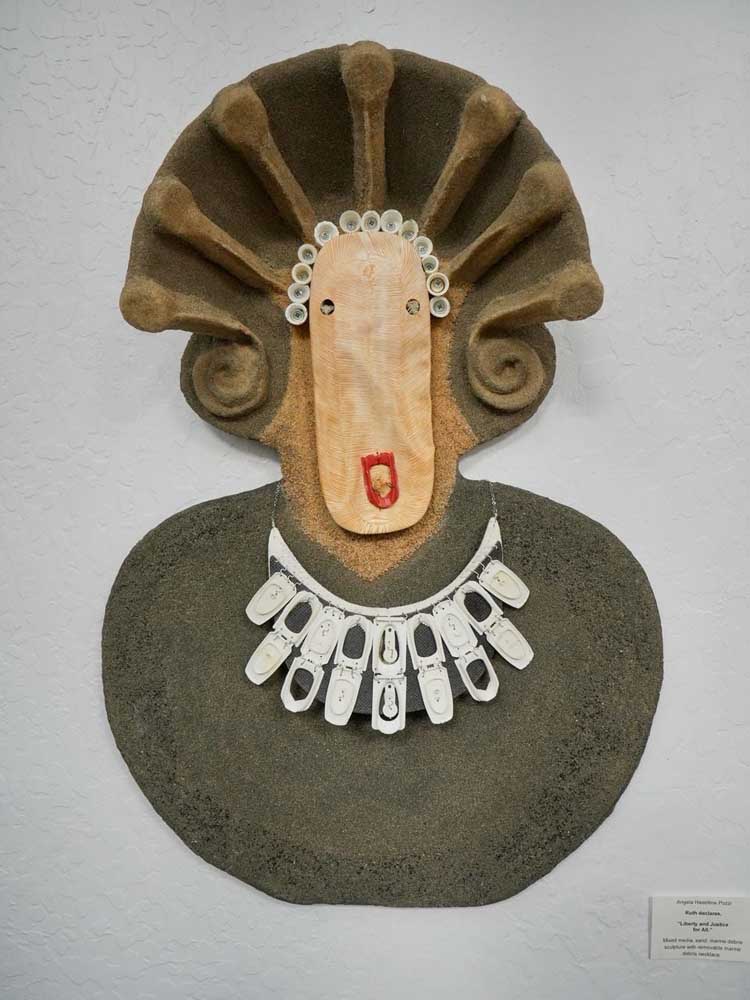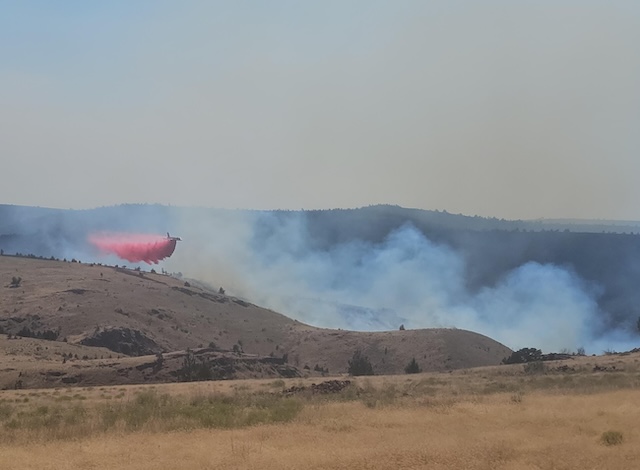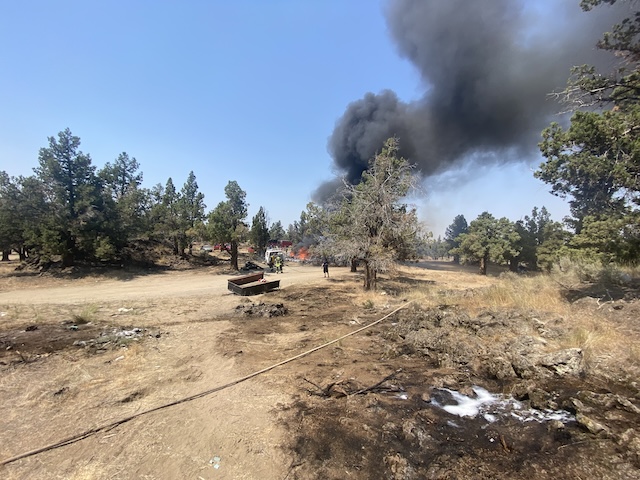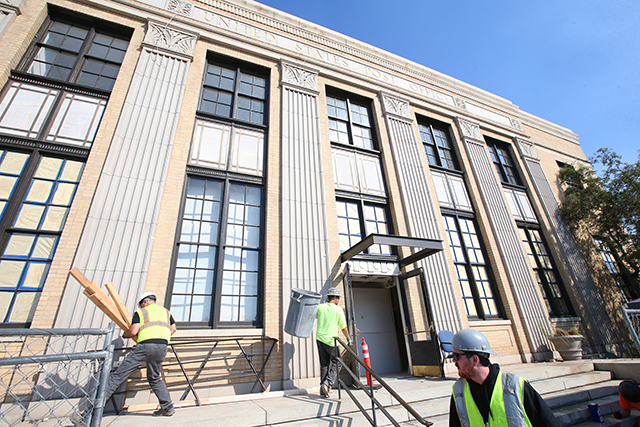Oregon artist’s 84-foot dragon sculpture burned down, twice. Here’s what’s taking its place
Published 2:00 pm Sunday, June 9, 2024

- Artist Angela Haseltine Pozzi is opening an art gallery, thrift store and coffee shop just south of Bandon on U.S. Hwy. 101 called Art 101. This piece is titled titled “Ruth declares, Liberty and Justice for All” made with mixed media, sand and marine debris.
Two years ago, a dragon was taking shape along U.S. 101, just south of Bandon.
It was 12 feet tall and 84 feet long, designed by artist Angela Haseltine Pozzi from repurposed car bumpers, old tires and other discarded materials.
Trending
Trash, basically. It’s the common medium in Pozzi’s art.
The dragon was to be the showpiece of the newly reopening Art 101, a creative hub along the Oregon Coast housing an art gallery, thrift store, picnic area and coffee shop.
Then, a storm rolled through on Oct. 22, 2022, and lightning struck the dragon. It caught fire and burned hot and long, leaving behind nothing but a mound of melted rubber.
“The tires were a real issue when it burned up because it just didn’t stop,” Pozzi said. “It was horrifying, and it was devastating.”
Another storm two months later brought down an electrical line, which torched the dragon’s remains a second time.
Some people might have taken that as a sign. Not Pozzi.
Trending
“I just thought, OK, we need to show resilience,” she said. “We need to show nothing’s going to stop us.”
She went back to work. Instead of scales, she made feathers.
Where the dragon once stood, a phoenix would take shape.
“This is a very symbolic rise from the ashes,” Pozzi said, as she screwed the final feathers onto the new sculpture, named Bandonia. “I want to make it really spectacular.”
Washed ashore
Turning tragedy into beauty has been a theme in Pozzi’s life. When she first moved to the Oregon coast, she did so with money she received after a lawsuit over her late husband’s death.
Her husband, photographer Craig Pozzi, died in 2004 from a long-undiagnosed brain tumor. In 2007, a jury awarded her $4.5 million in a malpractice lawsuit related to his case, and she moved from Vancouver, Washington, to Bandon to focus on her art, setting up a studio and gallery in 2008 called Art 101.
Among the bits of trash that washed up on the beach by her new home, she saw opportunity.
“I always see the possibility in strange materials,” Pozzi said. “I spent 30 years as an art teacher without a budget, and so I was always looking for interesting supplies for my students to work with that were cheap or free.”
Trash is cheap, and soon marine debris would become the basis of Pozzi’s nonprofit art and education project, Washed Ashore, founded in 2010. Using trash collected from local beaches, Pozzi and other volunteers constructed large-scale outdoor sculptures of sea life, aimed at putting a spotlight on the growing problem of ocean trash. That same year, Pozzi closed Art 101 to focus on the new nonprofit.
Washed Ashore’s traveling exhibits can be found at museums, zoos, aquariums and botanical gardens around the country. The project continues, with a home base at Pony Village Mall in North Bend. Several sculptures are also on permanent display at Bandon’s Fisheries Warehouse.
But after 11 years as founder and artistic director, Pozzi retired from Washed Ashore in 2021. She wanted to be able to collaborate with her artist daughter, Nicola Bianca Pozzi, and build a business she could leave to her children — aims that aren’t possible with a 501c3 run by a board of directors.
She left Washed Ahore, created a B Corp called ReUpIt and began work to reopen and expand Art 101.
Bandonia the Phoenix
In 2016, Washed Ashore took nine sculptures to an international Our Ocean conference at the U.S. State Department. An events company printed a custom plastic display backdrop for the exhibit — and planned to throw it away afterward.
“People don’t make the connections,” Pozzi said. “They do eco-friendly events, but then they buy the bottled water for all the participants.”
Pozzi saved that plastic backdrop and used it to shape the body of her phoenix.
Aside from a stainless-steel frame, every part of the phoenix is made from reused materials. The feathers are cut from plastic car bumpers — which can’t be recycled and end up in landfills constantly. They turn out to be a great sculpting material because they don’t fade or go brittle.
The phoenix’s claws are made of racing tires and car headlights. Stainless-steel kitchen utensils hang from the wings and create the sounds of a wind chime when the sea breeze catches them.
At 14 feet tall, with a 22-foot wingspan and 64-foot tail, Bandonia the Phoenix is the largest sculpture at Art 101. Many more pieces can be found inside the gallery.
There’s a three-paneled coral reef constructed from discarded clothes, fabrics and other debris.
A creature named Literella is made from old Dorito bags, discarded toothbrushes, gloves, applesauce containers, fake fur from old stuffed animals, and so much more.
Across the room stands the Fossil Fuel Monster, with gas nozzles for hands and a trunk made from an oil drum.
Along the walls are pieces from Pozzi’s “Unhuman” series of sculptures with removable (and wearable) marine debris jewelry.
Each sculpture is part of a greater storyline that Pozzi and her daughter have created of creatures that have come to earth to show humans how to do a better job of taking care of the planet.
Art 101
If Pozzi’s sculpting materials aren’t found on the beach, they are bought by the pound at Goodwill outlet stores (colloquially known as “The Bins”). The stores are the last stop for the thrift stores’ donated stock before the landfill.
Through those regular Bins shopping trips, Pozzi has collected quite a few high-quality thrifted finds. Those items are now for sale in the Polka Dot Thrift Shop inside a yurt at Art 101.
Art 101 also has a coffee shop, and a gift shop where visitors can buy things like earrings made from pieces of soda cans and car parts. Nicola Bianca Pozzi, a pen-to-paper artist, has her work printed on puzzles, locally printed T-shirts and reusable bags made from water bottles.
In honor of Angela Haseltine Pozzi’s sister, Suzy Haseltine McDonald, an avid cyclist who died of colon cancer, there’s Suzy’s Cycle Stop. It’s a place for cyclists to rest, air their tires and grab a snack along the Coast Highway.
And Pozzi has more dreams for the art park. A second yurt, which currently holds much of her art supplies (aka trash), will eventually be turned into a spaceship. She’s collecting silver, white and black car bumpers for the effort and planning to use old racing tires as round windows.
One day, she’d love to create a miniature golf course, with statues made of repurposed materials integrated into the course. There are plans for a dog park as well.
All of it, Pozzi said, is to get people excited by “joyous sustainability.”
“I want people to find joy in the artwork,” she said, “but also wake up to the fact that we’re throwing a lot of stuff away. We could make better choices.”








